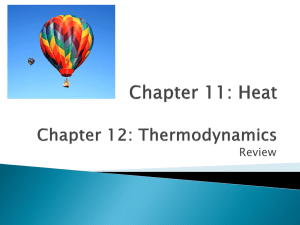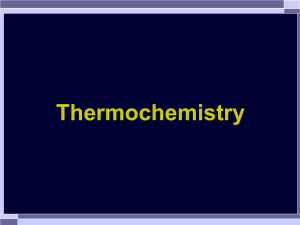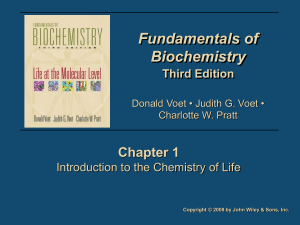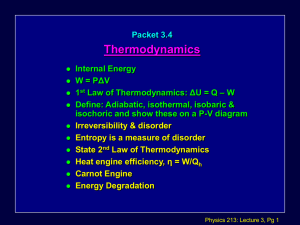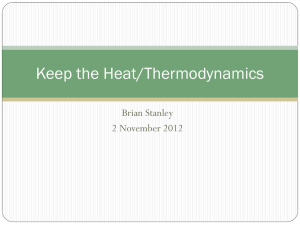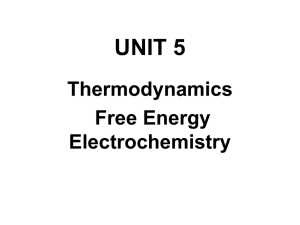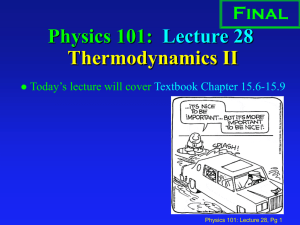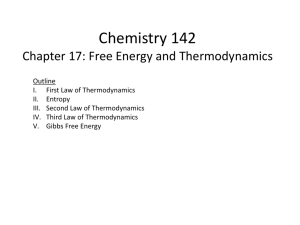Chapter 19 Chemical Thermodynamics
advertisement
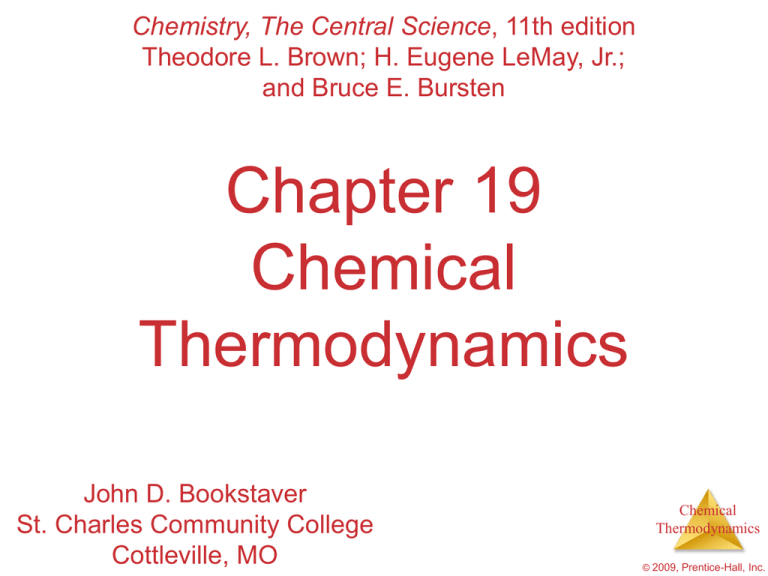
Chemistry, The Central Science, 11th edition Theodore L. Brown; H. Eugene LeMay, Jr.; and Bruce E. Bursten Chapter 19 Chemical Thermodynamics John D. Bookstaver St. Charles Community College Cottleville, MO Chemical Thermodynamics © 2009, Prentice-Hall, Inc. First Law of Thermodynamics • You will recall from Chapter 5 that energy cannot be created nor destroyed. • Therefore, the total energy of the universe is a constant. • Energy can, however, be converted from one form to another or transferred from a system to the surroundings or vice versa. Chemical Thermodynamics © 2009, Prentice-Hall, Inc. Spontaneous Processes • Spontaneous processes are those that can proceed without any outside intervention. • The gas in vessel B will spontaneously effuse into vessel A, but once the gas is in both vessels, it will not spontaneously return to vessel B. Chemical Thermodynamics © 2009, Prentice-Hall, Inc. Spontaneous Processes Processes that are spontaneous in one direction are nonspontaneous in the reverse direction. Chemical Thermodynamics © 2009, Prentice-Hall, Inc. Spontaneous Processes • Processes that are spontaneous at one temperature may be nonspontaneous at other temperatures. • Above 0 C it is spontaneous for ice to melt. • Below 0 C the reverse process is spontaneous. Chemical Thermodynamics © 2009, Prentice-Hall, Inc. Reversible Processes In a reversible process the system changes in such a way that the system and surroundings can be put back in their original states by exactly reversing the process. Chemical Thermodynamics © 2009, Prentice-Hall, Inc. Irreversible Processes • Irreversible processes cannot be undone by exactly reversing the change to the system. • Spontaneous processes are irreversible. Chemical Thermodynamics © 2009, Prentice-Hall, Inc. Entropy • Entropy (S) is a term coined by Rudolph Clausius in the 19th century. • Clausius was convinced of the significance of the ratio of heat delivered and the temperature at which it is delivered, q . T Chemical Thermodynamics © 2009, Prentice-Hall, Inc. Entropy • Entropy can be thought of as a measure of the randomness of a system. • It is related to the various modes of motion in molecules. Chemical Thermodynamics © 2009, Prentice-Hall, Inc. Entropy • Like total energy, E, and enthalpy, H, entropy is a state function. • Therefore, S = Sfinal Sinitial Chemical Thermodynamics © 2009, Prentice-Hall, Inc. Entropy For a process occurring at constant temperature (an isothermal process), the change in entropy is equal to the heat that would be transferred if the process were reversible divided by the temperature: qrev S = T Chemical Thermodynamics © 2009, Prentice-Hall, Inc. Second Law of Thermodynamics The second law of thermodynamics states that the entropy of the universe increases for spontaneous processes, and the entropy of the universe does not change for reversible processes. Chemical Thermodynamics © 2009, Prentice-Hall, Inc. Second Law of Thermodynamics In other words: For reversible processes: Suniv = Ssystem + Ssurroundings = 0 For irreversible processes: Suniv = Ssystem + Ssurroundings > 0 Chemical Thermodynamics © 2009, Prentice-Hall, Inc. Second Law of Thermodynamics These last truths mean that as a result of all spontaneous processes the entropy of the universe increases. Chemical Thermodynamics © 2009, Prentice-Hall, Inc. Entropy on the Molecular Scale • Ludwig Boltzmann described the concept of entropy on the molecular level. • Temperature is a measure of the average kinetic energy of the molecules in a sample. Chemical Thermodynamics © 2009, Prentice-Hall, Inc. Entropy on the Molecular Scale • Molecules exhibit several types of motion: – Translational: Movement of the entire molecule from one place to another. – Vibrational: Periodic motion of atoms within a molecule. – Rotational: Rotation of the molecule on about an axis or rotation about bonds. Chemical Thermodynamics © 2009, Prentice-Hall, Inc. Entropy on the Molecular Scale • Boltzmann envisioned the motions of a sample of molecules at a particular instant in time. – This would be akin to taking a snapshot of all the molecules. • He referred to this sampling as a microstate of the thermodynamic system. Chemical Thermodynamics © 2009, Prentice-Hall, Inc. Entropy on the Molecular Scale • Each thermodynamic state has a specific number of microstates, W, associated with it. • Entropy is S = k lnW where k is the Boltzmann constant, 1.38 1023 J/K. Chemical Thermodynamics © 2009, Prentice-Hall, Inc. Entropy on the Molecular Scale • Entropy increases with the number of microstates in the system • The number of microstates and, therefore, the entropy tends to increase with increases in – Temperature. – Volume. – The number of independently moving molecules. Chemical Thermodynamics © 2009, Prentice-Hall, Inc. Entropy and Physical States • Entropy increases with the freedom of motion of molecules. • Therefore, S(g) > S(l) > S(s) Chemical Thermodynamics © 2009, Prentice-Hall, Inc. Solutions Generally, when a solid is dissolved in a solvent, entropy increases. Chemical Thermodynamics © 2009, Prentice-Hall, Inc. Entropy Changes • In general, entropy increases when – Gases are formed from liquids and solids; – Liquids or solutions are formed from solids; – The number of gas molecules increases; – The number of moles increases. Chemical Thermodynamics © 2009, Prentice-Hall, Inc. Third Law of Thermodynamics The entropy of a pure crystalline substance at absolute zero is 0. Chemical Thermodynamics © 2009, Prentice-Hall, Inc. Sample Exercise 19.3 Predicting the Sign of ΔS Predict whether ΔS is positive or negative for each of the following processes, assuming each occurs at constant temperature: Solution Analyze: We are given four equations and asked to predict the sign of ΔS for each chemical reaction. Plan: The sign of ΔS will be positive if there is an increase in temperature, an increase in the volume in which the molecules move, or an increase in the number of gas particles in the reaction. The question states that the temperature is constant. Thus, we need to evaluate each equation with the other two factors in mind. Solve: (a) The evaporation of a liquid is accompanied by a large increase in volume. One mole of water (18 g) occupies about 18 mL as a liquid and if it could exist as a gas at STP it would occupy 22.4 L. Because the molecules are distributed throughout a much larger volume in the gaseous state than in the liquid state, an increase in motional freedom accompanies vaporization. Therefore, ΔS is positive. (b) In this process the ions, which are free to move throughout the volume of the solution, form a solid in which they are confined to a smaller volume and restricted to more highly constrained positions. Thus, ΔS is negative. (c) The particles of a solid are confined to specific locations and have fewer ways to move (fewer microstates) than do the molecules of a gas. Because O2 gas is converted into part of the solid product Fe2O3, ΔS is negative. (d) The number of moles of gases is the same on both sides of the equation, and so the entropy change will be small. The sign of ΔS is impossible to predict based on our discussions thus far, but we can predict that ΔS will be close to zero. Chemical Thermodynamics © 2009, Prentice-Hall, Inc. Sample Exercise 19.3 Predicting the Sign of ΔS Practice Exercise Indicate whether each of the following processes produces an increase or decrease in the entropy of the system: Answer: (a) increase, (b) decrease, (c) decrease, (d) decrease Chemical Thermodynamics © 2009, Prentice-Hall, Inc. Sample Exercise 19.4 Predicting Which Sample of Matter Has the Higher Entropy Choose the sample of matter that has greater entropy in each pair, and explain your choice: (a) 1 mol of NaCl(s) or 1 mol of HCl(g) at 25 °C, (b) 2 mol of HCl(g) or 1 mol of HCl(g) at 25 °C, (c) 1 mol of HCl(g) or 1 mol of Ar(g) at 298 K. Solution Analyze: We need to select the system in each pair that has the greater entropy. Plan: To do this, we examine the state of the system and the complexity of the molecules it contains. Solve: (a) Gaseous HCl has the higher entropy because gases have more available motions than solids. (b) The sample containing 2 mol of HCl has twice the number of molecules as the sample containing 1 mol. Thus, the 2-mol sample has twice the number of microstates and twice the entropy when they are at the same pressure. (c) The HCl sample has the higher entropy because the HCl molecule is capable of storing energy in more ways than is Ar. HCl molecules can rotate and vibrate; Ar atoms cannot. Practice Exercise Choose the substance with the greater entropy in each case: (a) 1 mol of H2(g) at STP or 1 mol of H2(g) at 100 °C and 0.5 atm, (b) 1 mol of H2O(s) at 0 °C or 1 mol of H2O(l) at 25 °C, (c) 1 mol of H2(g) at STP or 1 mol of SO2(g) at STP, (d) 1 mol of N2O4(g) at STP or 2 mol of NO2(g) at STP. Answers: (a) 1 mol of H2(g) at 100 °C and 0.5 atm, (b) 1 mol of H2O(l) at 25 °C, (c) 1 mol of SO2(g) at STP, (d) 2 mol of NO2(g) at STP Chemical Thermodynamics © 2009, Prentice-Hall, Inc. Standard Entropies • These are molar entropy values of substances in their standard states. • Standard entropies tend to increase with increasing molar mass. Chemical Thermodynamics © 2009, Prentice-Hall, Inc. Standard Entropies Larger and more complex molecules have greater entropies. Chemical Thermodynamics © 2009, Prentice-Hall, Inc. Entropy Changes Entropy changes for a reaction can be estimated in a manner analogous to that by which H is estimated: S = nS(products) — mS(reactants) where n and m are the coefficients in the balanced chemical equation. Chemical Thermodynamics © 2009, Prentice-Hall, Inc. Sample Exercise 19.5 Calculating ΔS from Tabulated Entropies Calculate ΔSº for the synthesis of ammonia from N2(g) and H2(g) at 298 K: Solution N2(g) + 3 H2(g) → 2 NH3(g) Analyze: We are asked to calculate the entropy change for the synthesis of NH3(g) from its constituent elements. Plan: We can make this calculation using Equation 19.8 and the standard molar entropy values for the reactants and the products that are given in Table 19.2 and in Appendix C. Solve: Using Equation 19.8, we have ΔS° = 2S°(NH3) - [S°(N2) + 3S°(H2)] Substituting the appropriate S° values from Table 19.2 yields ΔS° = (2 mol)(192.5 J/mol-K) - [(1 mol)(191.5 J/mol-K) + (3 mol)(130.6 J/mol-K)] = -198.3 J/K Check: The value for ΔS° is negative, in agreement with our qualitative prediction based on the decrease in the number of molecules of gas during the reaction. Practice Exercise Using the standard entropies in Appendix C, calculate the standard entropy change, ΔS°, for the following reaction at 298 K: Al2O3(s) + 3 H2(g) → 2 Al(s) + 3 H2O(g) Answers: 180.39 J/K Chemical Thermodynamics © 2009, Prentice-Hall, Inc. Entropy Changes in Surroundings • Heat that flows into or out of the system changes the entropy of the surroundings. • For an isothermal process: Ssurr = qsys T • At constant pressure, qsys is simply H for the system. Chemical Thermodynamics © 2009, Prentice-Hall, Inc. Entropy Change in the Universe • The universe is composed of the system and the surroundings. • Therefore, Suniverse = Ssystem + Ssurroundings • For spontaneous processes Suniverse > 0 Chemical Thermodynamics © 2009, Prentice-Hall, Inc. Entropy Change in the Universe • Since Ssurroundings = qsystem and qsystem = Hsystem T This becomes: Hsystem Suniverse = Ssystem + T Multiplying both sides by T, we get TSuniverse = Hsystem TSsystem Chemical Thermodynamics © 2009, Prentice-Hall, Inc. Gibbs Free Energy • TSuniverse is defined as the Gibbs free energy, G. • When Suniverse is positive, G is negative. • Therefore, when G is negative, a process is spontaneous. Chemical Thermodynamics © 2009, Prentice-Hall, Inc. Gibbs Free Energy 1. If G is negative, the forward reaction is spontaneous. 2. If G is 0, the system is at equilibrium. 3. If G is positive, the reaction is spontaneous in the reverse direction. Chemical Thermodynamics © 2009, Prentice-Hall, Inc. Standard Free Energy Changes Analogous to standard enthalpies of formation are standard free energies of formation, G. f G = nGf (products) mG f(reactants) where n and m are the stoichiometric coefficients. Chemical Thermodynamics © 2009, Prentice-Hall, Inc. Free Energy Changes At temperatures other than 25°C, G° = H TS How does G change with temperature? Chemical Thermodynamics © 2009, Prentice-Hall, Inc. Sample Exercise 19.6 Calculating Free-Energy Change from ΔH°, T, ΔS° Calculate the standard free energy change for the formation of NO(g) from N2(g) and O2(g) at 298 K: N2(g) + O2(g) → 2 NO(g) given that ΔH° = 180.7 kJ and ΔS° = 24.7 J/K. Is the reaction spontaneous under these circumstances? Solution Analyze: We are asked to calculate ΔG° for the indicated reaction (given ΔH°, ΔS° and T) and to predict whether the reaction is spontaneous under standard conditions at 298 K. Plan: To calculate ΔG°, we use Equation 19.12, ΔG° = ΔH° – T ΔS°. To determine whether the reaction is spontaneous under standard conditions, we look at the sign of ΔG°. Solve: Because ΔG° is positive, the reaction is not spontaneous under standard conditions at 298 K. Comment: Notice that we had to convert the units of the T ΔS° term to kJ so that they could be added to the ΔH° term, whose units are kJ. Practice Exercise A particular reaction has ΔH° = 24.6 kJ and ΔS° = 132 J/K at 298 K. Calculate ΔG°. Is the reaction spontaneous under these conditions? Answers: ΔG° = –14.7 kJ; the reaction is spontaneous. Chemical Thermodynamics © 2009, Prentice-Hall, Inc. Sample Exercise 19.7 Calculating Standard Free-Energy Change from Free Energies of Formation (a) Use data from Appendix C to calculate the standard free-energy change for the following reaction at 298 K: P4(g) + 6 Cl2(g) → 4 PCl3(g) (b) What is ΔG° for the reverse of the above reaction? Solution Analyze: We are asked to calculate the free-energy change for the indicated reaction and then to determine the free-energy change of its reverse. Plan: To accomplish our task, we look up the free-energy values for the products and reactants and use Equation 19.14: We multiply the molar quantities by the coefficients in the balanced equation, and subtract the total for the reactants from that for the products. Solve: (a) Cl2(g) is in its standard state, so ΔG°f is zero for this reactant. P4(g), however, is not in its standard state, so ΔG°f is not zero for this reactant. From the balanced equation and using Appendix C, we have: Chemical Thermodynamics © 2009, Prentice-Hall, Inc. Sample Exercise 19.7 Calculating Standard Free-Energy Change from Free Energies of Formation Solution (continued) The fact that ΔG° is negative tells us that a mixture of P4(g), Cl2(g), and PCl3(g) at 25 °C, each present at a partial pressure of 1 atm, would react spontaneously in the forward direction to form more PCl 3. Remember, however, that the value of ΔG° tells us nothing about the rate at which the reaction occurs. (b) Remember that ΔG = G (products) – G (reactants). If we reverse the reaction, we reverse the roles of the reactants and products. Thus, reversing the reaction changes the sign of ΔG, just as reversing the reaction changes the sign of ΔH. (Section 5.4) Hence, using the result from part (a): 4 PCl3(g) → P4(g) + 6 Cl2(g) ΔG° = +1102.8 kJ Practice Exercise By using data from Appendix C, calculate ΔG° at 298 K for the combustion of methane: CH4(g) + 2 O2(g) → CO2(g) + 2 H2O(g). Answer: –800.7 kJ Chemical Thermodynamics © 2009, Prentice-Hall, Inc. Free Energy and Temperature • There are two parts to the free energy equation: H— the enthalpy term – TS — the entropy term • The temperature dependence of free energy, then comes from the entropy term. Chemical Thermodynamics © 2009, Prentice-Hall, Inc. Free Energy and Temperature Chemical Thermodynamics © 2009, Prentice-Hall, Inc. Free Energy and Equilibrium Under any conditions, standard or nonstandard, the free energy change can be found this way: G = G + RT lnQ (Under standard conditions, all concentrations are 1 M, so Q = 1 and lnQ = 0; the last term drops out.) Chemical Thermodynamics © 2009, Prentice-Hall, Inc. Free Energy and Equilibrium • At equilibrium, Q = K, and G = 0. • The equation becomes 0 = G + RT lnK • Rearranging, this becomes G = RT lnK or, -G K = e RT Chemical Thermodynamics © 2009, Prentice-Hall, Inc.
